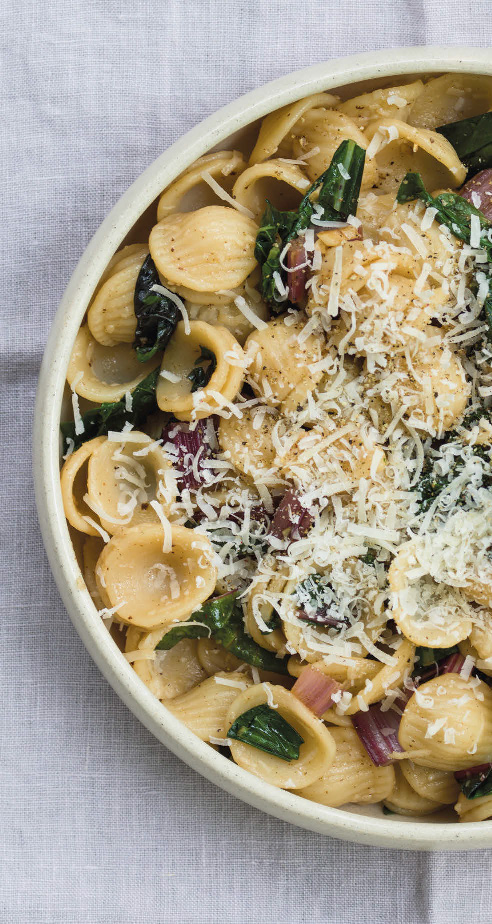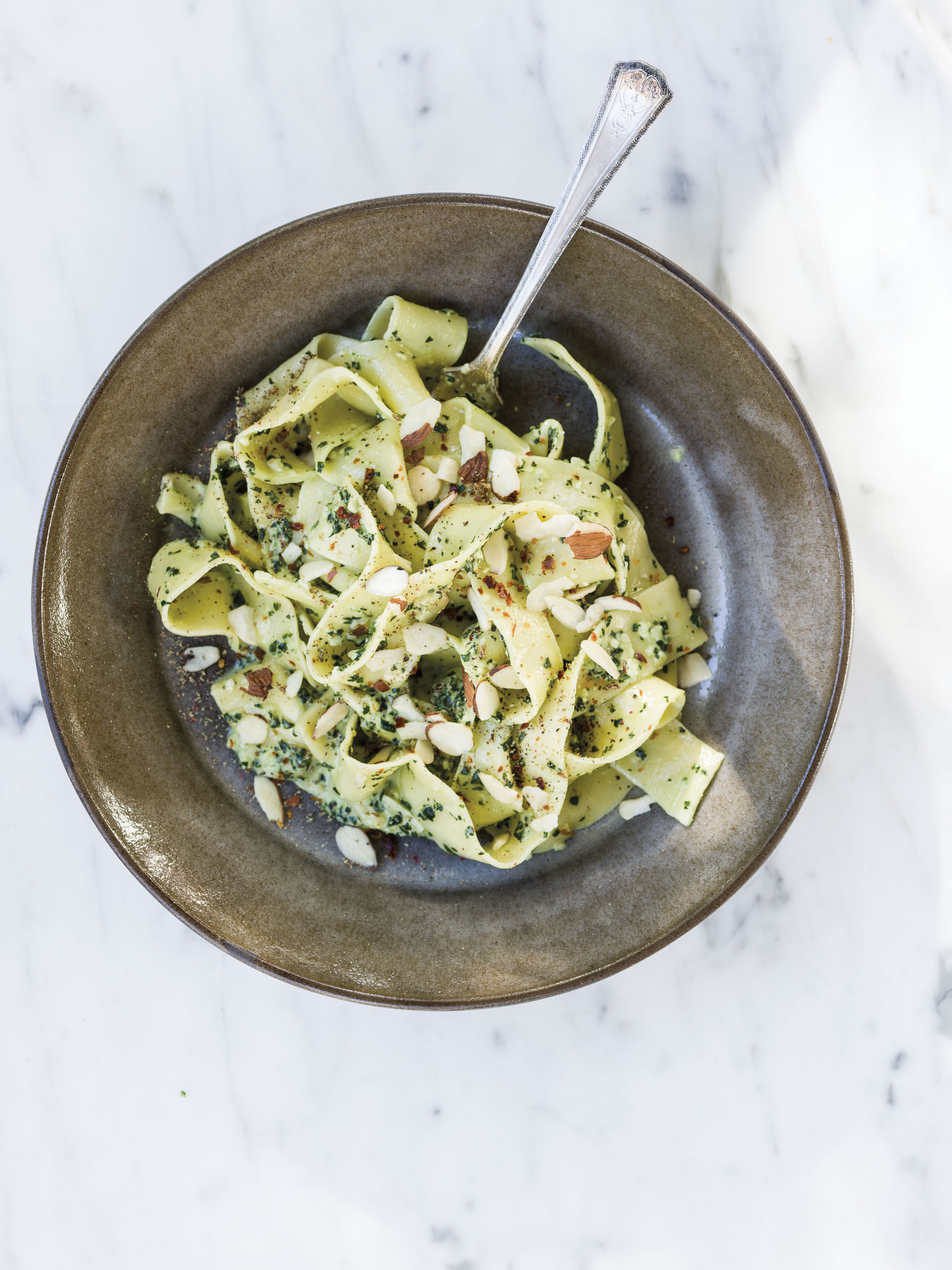Dress it Up

There’s no better way to embellish an abundance of spring greens than with homemade salad dressing.
Technique & Recipes Bryn Mooth
You’ve whipped up a beautiful salad with local spring vegetables … what do you toss it with? If you’re like most Americans, you open up a bottle of purchased salad dressing. One report from 20 years ago cited a whopping $1.4 billion as the amount of money U.S. consumers spent on pourable salad dressing. (And raise your hand if your fridge is a forest of barely emptied bottles of various dressings.)
We’re here to change your habits and open your mind to the endless possibilities of homemade salad dressing.
Bottled dressing is convenient, sure. It can be relatively cheap, unless you opt for a gourmet or organic variety, which can get pricey.
And then there’s quality. Consider a brand-name, shelf-stable “Italian” dressing: Its label lists 14 ingredients including high fructose corn syrup, xanthan gum, calcium disodium EDTA, and something called “spice.” And the first ingredient is water.
A homemade Italian vinaigrette contains oil, vinegar, salt, pepper, and dried Italian herbs. No water, no corn syrup, no preservatives, no mystery spices. And that combination of ingredients rings up at about $2.50.
If you’re watching your sodium intake and also wary of sneaky added sugars, making your own salad dressing puts you in control. Even bottled dressings labeled “lite” have double-digit measures of sodium and sugar analogues like sucralose.
Rather than casting shade on store-bought dressing, let’s consider all the pluses of making your own vinaigrette. It’s endlessly adaptable. It’s ridiculously simple. It’s quite pleasurable to whip up your own creation. It’s completely delicious.
The Acid-Fat Dressing Formula
Here’s the most elemental way to dress a salad: Toss a bowl full of greens with a drizzle of good olive oil and the juice of half a lemon, add a pinch of salt and fresh ground pepper. In spring when locally grown baby lettuces are crisp and fresh and flavorful, you don’t need anything more.
Culinary wisdom says that the formula for any vinaigrette dressing is 1 part acid (vinegar or lemon juice) to 3 parts olive oil. You can alter that formula if you’re using a milder acid like champagne vinegar and go for a ratio closer to 1:2.
Good olive oil is a great foundation for flavor, but you can substitute a neutral-tasting oil like grapeseed or canola for half the olive oil called for in most recipes. For the acid, lemon or lime juice, local MadHouse vinegar in any flavor, or good old apple cider vinegar are all excellent choices. Sherry, champagne/prosecco, white wine, and red-wine vinegars all add unique flavor profiles and degrees of sharpness, so experiment to find your favorite.
Adding a bit of Dijon mustard helps the dressing emulsify (the oil and acid holding together in a smooth blend). For a bolder taste, smash a garlic clove or a chunk of peeled shallot and let it steep in the acid for about an hour before finishing the dressing. I like to remove the garlic or shallot; those flavors get too intense for my taste after a day or two in the fridge.
Instead of whisking or blending homemade dressing, I prefer shaking the ingredients together in a lidded container. A pint Mason jar with a tight-sealing lid works great, as does a purpose-built jar like OXO brand’s dressing shaker, which has a pour spout and a tight-fitting flip-top closure. Dressings will keep in the refrigerator for up to two weeks.
Leave the bottled stuff on the grocery store shelf and shake up your own dressing.
Salad Dressing Tips
Always season your lettuce with just a pinch of salt before adding dressing. You’ll awaken the greens’ natural flavors (it’s surprising how much taste good lettuce has), and need less dressing as a result.
Drizzle a bit of dressing into the bowl, not on top of the lettuce, and toss gently to lightly coat. This way, you’ll avoid a soggy, overdressed disappointment of a salad. You can assemble the salad in advance and keep it chilled, but don’t add dressing until just before serving.
Emulsification is the process of mixing oil and vinegar together so that the blend is stable. Because oil and vinegar naturally don’t mix, an ingredient like egg, mustard, or mayo can help the mixture hold together. (I think emulsification is overrated; if the dressing separates, just give it a shake.)
Whole or reduced-fat plain yogurt adds a pleasantly tangy creaminess and can substitute for all or part of the mayo in many dressing recipes.
Whole-grain or smooth Dijon mustard adds great flavor and helps blend the oil and vinegar.
Egg is a good emulsifier, and a key ingredient in a classic Caesar dressing. If you’re concerned about using raw egg, substitute 2 or 3 tablespoons of mayo, Greek yogurt, or silken tofu. Or you can coddle the egg before blending into dressing: Place a whole, fresh, local egg in a coffee cup; fill the cup with boiling water and let sit for 60 seconds, then drain and use immediately.
For herbs, go for fresh tender herbs like parsley and basil, or dried woody herbs like oregano and thyme. Dried herbs have more flavor, so use 1 teaspoon dried herbs or 1 tablespoon fresh. Dried blends like Herbes de Provence or Italian seasoning make great flavorings for vinaigrette.
Green Goddess Dressing
makes about 6 ounces
¾ cup plain Greek yogurt (regular or low-fat)
2 Tbsp. mayonnaise
1 small clove garlic, peeled
Pinch of salt
1 Tbsp. lemon juice
1 Tbsp. white wine vinegar
¼ cup minced chives
¼ cup chopped parsley
2 Tbsp. chopped tarragon
Freshly ground pepper
In a tall jar using an immersion blender, whirl together Greek yogurt and mayonnaise. Use the blade of a chef’s knife to smash the garlic clove on a cutting board, sprinkle it with salt, and mash it into a paste. Add the garlic-salt paste, lemon juice, vinegar, herbs, and pepper to the jar. Whirl to combine well and create a smooth, evenly green mixture. Season to taste with salt and pepper.
Julie Francis of Nectar Personal Chef contributed this recipe to The Findlay Market Cookbook. It’ll snap you right back to the 1970s, in the best way.
Best Basic Vinaigrette
makes about 1 cup
⅓ cup white-wine or champagne vinegar
2 Tbsp. Dijon mustard
1 Tbsp. local honey
½ cup extra-virgin olive oil
Pinch of salt and ground pepper
In a lidded jar, shake the vinegar, mustard, and honey to blend. Add olive oil and shake well until combined; season with salt and pepper
I have a jar of this simple dressing in my refrigerator at all times. Change things up by substituting fresh lemon or lime juice for half the vinegar.
Blue Cheese Dressing
makes about 1½ cups
½ cup sour cream or plain yogurt (regular or low-fat)
½ cup mayonnaise
1 Tbsp. finely minced shallot (rinsed in cold water and drained, to tame the sharp taste)
Juice of ½ lemon
4 oz. quality blue cheese, crumbled
Pinch of salt and cracked pepper
In a lidded jar, whisk together sour cream and mayonnaise to combine. Whisk in shallot and lemon juice; add blue cheese and stir to combine. Season with salt and pepper.
Top an iceberg wedge with this dressing, plus crumbled bacon, diced tomato, snipped chives, and a shower of black pepper and you’ll have a dish to rival any steakhouse’s signature salad.
Easy Italian Dressing
makes about 1½ cups
1 cup (loosely packed) chopped fresh parsley
10 fresh basil leaves
¼ tsp. dried oregano
1 clove garlic, chopped
¼ cup red or white wine vinegar
1 to 2 Tbsp. local honey, to taste
¾ cup extra-virgin olive oil
Salt and freshly ground pepper
Combine parsley, basil, oregano, garlic, vinegar, and honey in a tall jar and use an immersion blender to blend into a paste. Slowly add olive oil as you blend, creating a smooth mixture. Season with salt and pepper.
Bryn’s long career in publishing took a left turn sometime around 2010, when she discovered the joy of food writing. Since then, she’s found professional nirvana as the editor of Edible Ohio Valley, author of The Findlay Market Cookbook, and occasional instructor at The Cooking School at Jungle Jim’s. Find her seasonal recipes at writes4food.com.





